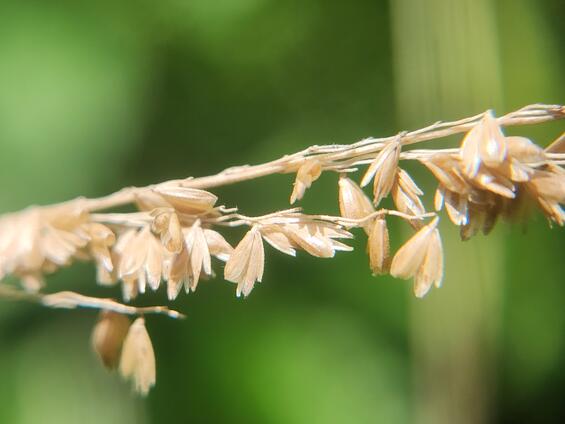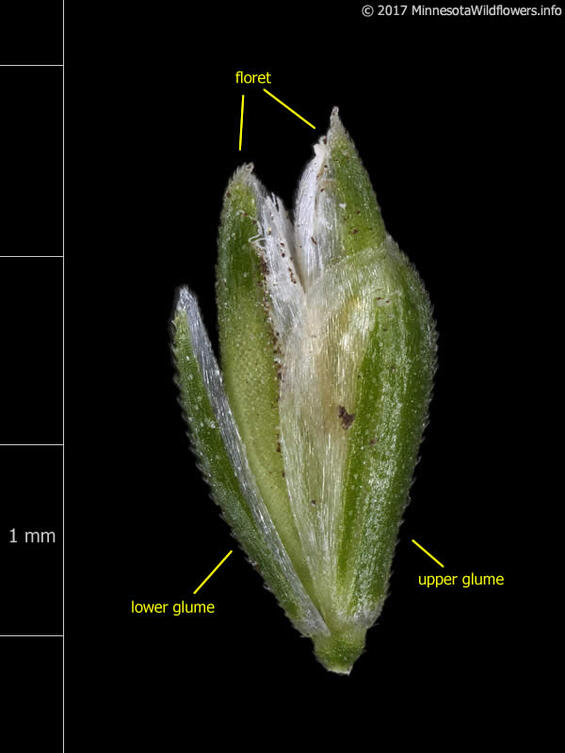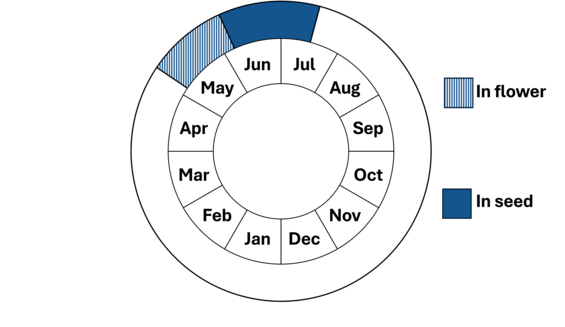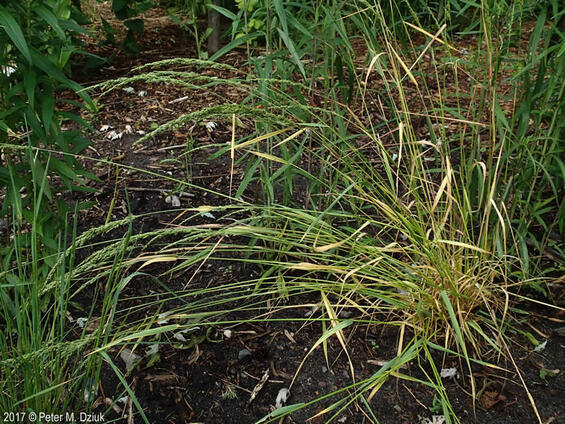- Scientific name: Sphenopholis obtusata (Michx.) Scribn.
Species of Greatest Conservation Need (MA State Wildlife Action Plan)
Description

Photo credit: Matthew Charpentier
Prairie wedgescale (Sphenopholis obtusata) is a slender perennial grass (family Poaceae). It grows in small tufts, reaching 20-130 cm (0.66-4.25 ft) tall. Plants are usually leafy at the base. Leaves are rough-textured or pubescent. The main leaf blades are 2-8 mm (0.08-0.3 in) wide and 5-14 cm (2-5.5 in) long; sheaths are smooth or hairy. The slender spike-like flower panicles are typically erect, measuring 5-15 cm (2-6 in) long. The panicle is composed of spikelets, or flowering branchlets, which are few-flowered, set far apart, and generally 2.5-3mm (0.1-0.11 in) long.
At the base of each spikelet, there are two small scales or bracts called the first and second glumes. The glumes are mostly smooth with a few rough hairs near their tips and smooth along their edges. The glumes are dissimilar; the first glume is relatively narrow, measuring 1-3 mm (0.04-0.11 in) long and 0.1-0.3 mm (0.004-0.011 in) wide, and has a rough-textured keel. The second glume is relatively broader, measuring 1.2-4.2 mm (0.05-0.16 in) long and 0.5-1 mm (0.02-0.04 in) wide, and broad-rounded to truncate at its apex. The first glumes are typically less than 1/3 as wide as the second glumes. The rest of the spikelet is made up of 2–3 florets arranged in alternating rows on a central stalk or rachilla. Each floret has an outer scale, or lemma, an inner scale, or palea, with stamens and pistil between them. The lemmas of prairie wedgescale are awnless, blunt to acute at their tips, smooth or with minute rough hairs. The first lemma measures 1.4-4.4 mm (0.06-0.16 in) long, slightly longer than the second lemma, which measures 0.3-0.7 mm (0.01 - 0.03 in) long. Prairie wedgescale flowers in May; mature florets are present through June. Plants begin to senesce in early July.
Prairie wedgescale is similar in appearance to slender wedgescale (Sphenopholis intermedia) and shining wedgescale (S. nitida). The second lemma of shining wedgescale is strongly scabrous, whereas the second lemmas of slender wedgescale and prairie wedgescale are smooth or minutely scabrous. The spikelets of prairie wedgescale are generally shorter than those of slender wedgescale, measuring 2.5-3 mm (0.1-0.11 in) compared to 3-4.2 mm (0.11-0.16 in) long. Additionally, the anthers of prairie wedgescale are generally longer, measuring 0.5-0.8 mm (0.02-0.03 in) long, compared to those of slender wedgescale, which measure 0.3-0.5 mm (0.01-0.02 in) long.
Photo credit: Peter M Dziuk, MinnesotaWildflowers.info

Photo credit: Peter M Dziuk, MinnesotaWildflowers.info
Life cycle and behavior

Prairie wedgescale is a perennial grass and is wind pollinated. It flowers in May; mature florets are present through June. Plants begin to senesce in July. The flowering branches are held close to the stem when the plant is not in bloom. Once pollination is complete, the flowering branches again are pulled close to the stem.
Population status
Prairie wedgescale was regarded as state historical until it was recently observed. It has been added as a species of greatest conservation need in Massachusetts and maintained on the plant watch list. There is currently 1 occurrence of prairie wedgescale in the state verified since 1999. Prairie wedgescale is currently known from Worcester County, and is historically known from Essex, Hampden, Hampshire, Middlesex Nantucket, Norfolk, Suffolk and Worcester Counties. There are 8 specimens of Sphenopholis obtusata in Franklin, Hampshire, Hampden and Worcester Counties collected since 1999 in the Consortium of Northeastern Herbaria.
Distribution and abundance
Prairie wedgescale ranges from Ontario to British Columbia across Canada south to Florida and California, in all 48 states. It is considered possibly extirpated in Maine, New Hampshire and Vermont, critically imperiled in Ontario, New York, and Ohio, imperiled in California, Nevada, and Oregon, and vulnerable in Wyoming and Illinois. Most states do not have a state rank for this species (including Massachusetts).
Habitat
Prairie wedgescale inhabits dry, rocky soils derived from mafic bedrock high in magnesium or iron. It typically occurs on steep rock slopes, in canopy gaps of deciduous forests characterized by hickory (Carya spp.), hop hornbeam (Ostrya virginiana), and various oaks (Quercus spp.)
Healthy habitats are vital for supporting native wildlife and plants. Explore habitats and learn about conservation and restoration in Massachusetts.

Photo credit: Peter M Dziuk, MinnesotaWildflowers.info
Threats
Habitats of prairie wedgegrass are vulnerable to development, especially in the eastern half of the state.The lack of small-scale disturbances such as wind-throw or occasional fire may limit the ability of prairie wedgescale to compete with other species and germinate in bare soil areas. Its habitats are susceptible to exotic plant invasions from species such as swallowworts (Cynanchum spp.), shrub honeysuckle (Lonicera spp.), Japanese barberry (Berberis thunbergii), Canada bluegrass (Poa compressa), Asiatic bittersweet (Celastrus orbiculatus), and common buckthorn (Rhamnus cathartica). Invasive plants can out-compete native plants for nutrients and light, excluding them over time. The known populations of prairie wedgegrass are small, so a single stochastic event could wipe out a population as well.
Conservation
Due to its recent rediscovery in Massachusetts, sites documented to historically host prairie wedgescale should be resurveyed to determine whether populations still persist. The habitats of known populations should be evaluated for potential threats, including shading from dense canopy, invasive species, and other unknown threats. The best time to survey for the species is in June.
Research and monitoring aimed at understanding the natural history, biology, and population dynamics of prairie wedgescale are important. This species is known to respond favorably to fire management in other parts of its range. Carefully timed prescribed fire may reduce canopy closure and competition from other plants, and expose mineral soils required for prairie wedgescale germination and establishment. Prairie wedgescale habitat should be monitored for exotic invasive species.
Acknowledgement
MassWildlife acknowledges the expertise of Matthew Charpentier, who contributed substantially to the development of this fact sheet.
References
Gleason, Henry A., and Arthur Cronquist. Manual of Vascular Plants of Northeastern United States and Adjacent Canada, Second Edition. Bronx, NY: The New York Botanical Garden, 1991.
Haines, Arthur. Flora Novae Angliae. New England Wild Flower Society, Yale University Press, New Haven, CT. 2011.
Hitchcock, Albert Spear. Manual of the grasses of the United States. 1950. USDA Misc. Pub. 200. pp. 283 – 286.
Magee, Dennis W. Grasses of the Northeast. University of Massachusetts Press. Amherst and Boston. 2014, pp. 90 93.
NatureServe. 2025. NatureServe Network Biodiversity Location Data accessed through NatureServe Explorer [web application]. NatureServe, Arlington, Virginia. Available https://explorer.natureserve.org/. Accessed: 4/03/2025.
Contact
| Date published: | May 8, 2025 |
|---|